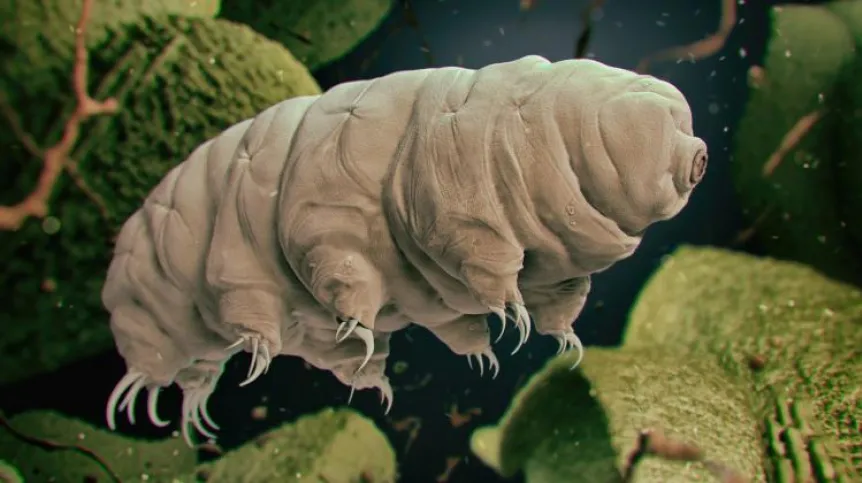
Rotifers, nematodes and tardigrades are invertebrates, in which suspension or extreme slowdown of the aging process occurs in the state of anhydrobiosis, that is, life activity reduction due to the lack of water. Understanding their life strategies can be crucial for medicine, biotechnology or astrobiology, researchers say.
Anhydrobiosis (from Greek, "life without water") was first described in 1702 by the Dutch naturalist Antoni van Leeuwenhoek. Currently, it is defined as a survival strategy for extreme dehydration without negative consequences in the form of various types of tissue or cellular damage. However, despite the increasing number of studies on cellular or physiological aspects of anhydrobiosis, we are still far from understanding this phenomenon.
Researchers from Poland and Italy collected and discussed all currently available information on the effect of anhydrobiosis on the aging process of tardigrades, nematodes and rotifers in the article "Staying young and fit? Ontogenetic and phylogenetic consequences of animal anhydrobiosis" published in the prestigious "Journal of Zoology".
The gradual deterioration of the body, aging, is considered to be the basic principle and common feature of living organisms, regardless of how they multiply and the number of cells they are built of. However - according to scientists - it appears that this inevitability of aging does not apply to some organisms from various taxonomic groups - both plants and animals.
"Among them, invertebrates seem to be the most interesting, with particular emphasis on tardigrades, capable of cryptobiosis, including its best known form called anhydrobiosis" - emphasizes the article co-author, Prof. Łukasz Kaczmarek from the Adam Mickiewicz University in Poznań.
Importantly, according to the authors of the article, the possibility of transition to anhydrobiosis and successfully exiting this state at any time in life, also after reaching the adult stage, has been recorded so far only for three types of invertebrates: rotifers (Rotifera), nematodes (Nematoda) and tardigrades (Tardigrada).
"According to the widely accepted hypothesis, the basic mechanism of anhydrobiosis is the suspension or slowing down of metabolism, which may explain the suspension or slowing down of the aging process observed in rotifers, nematodes and tardigrades. This, in turn, may co-occur with the improvement of the condition of these animals, increased fertility and increased longevity of their offspring" - says the article co-author, Prof. Hanna Kmita from the Adam Mickiewicz University in Poznań.
To explain the effect of anhydrobiosis on the aging process in these invertebrates, two models have been proposed. Their names refer to the classic tales: "Sleeping Beauty" and "The Picture of Dorian Gray".
Prof. Kmita explains that according to these models, in the body subject to anhydrobiosis, external signs of aging do not appear (Sleeping Beauty) or their severity depends on the duration of anhydrobiosis, meaning that the rate of aging decreases over its duration (The Picture of Dorian Gray). According to the published data, in the majority of the invertebrates, in which the effect of anhydrobiosis on aging has been studied, the "Sleeping Beauty" model seems to dominate.
"But these models do not clarify whether anhydrobiosis directly affects the mechanisms behind aging, or indirectly contributes to the extension of life by suppressing the possible causes of death" - adds Prof. Kmita.
The consequences of predictions of these models have not been studied yet in the context of survival rate and life expectancy of individuals, and the impact it may have on the evolution of these organisms.
In the opinion of the researchers, it appears that the slowing down or stopping of the aging process that accompanies anhydrobiosis may also slow down the evolution, because it extends the time required for the next generation to appear. "This slowing effect of anhydrobiosis seems to be evident in the poor morphological diversity of representatives of rotifers and land tardigrades" - explains Prof. Łukasz Kaczmarek.
Researchers argue that understanding life strategies used by rotifers, tardigrades and nematodes, at different levels of their organisms` organization, can be crucial for medicine, biotechnology or astrobiology. It will allow to develop effective methods for storing biological material as well as controlling the speed of biological processes.
"There seem to be many potential applications, from longer transplantation organs storage, through life extension, to space travel" - concludes Prof. Kaczmarek.
Researchers from the Adam Mickiewicz University in Poznań led by Prof. Hanna Kmita and Prof. Łukasz Kaczmarek are currently testing the "Sleeping Beauty" hypothesis on tardigrades. For now, they do not want to reveal details, although - in their opinion - their research will certainly have consequences for understanding the aging process of both tardigrades and other organisms.
More information can be found in the article: https://zslpublications.onlinelibrary.wiley.com/doi/10.1111/jzo.12677?fbclid=IwAR0RWJefobxW-OM4TenF-kkhc6zis2BVAcBO-I_P8YSJ23WGj3t9wSMLGbo&
PAP - Science in Poland
szu/ ekr/ kap/
tr. RL













